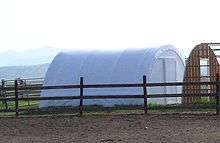Tension fabric building

Tension fabric buildings are constructed using a rigid frame which can consist of timber, steel, rigid plastic, or Aluminum and a sturdy fabric outer membrane. Once the frame is erected in place, the fabric cover is stretched over the frame. The fabric cover is tensioned to provide the stable structural support of the building. The fabric is tensioned using multiple methods varying by manufacturer, creating a tight fitting cover membrane. Compared to traditional structures may have lower operational costs,be naturally bright, be installed quickly, and be able to be re-located easily..
Usage
Tension fabric buildings have gained popularity over the last few decades in many industries including the following applications: hay and feed storage, horse riding arenas, commercial, manufacturing, warehousing, sand and salt storage for road maintenance departments, environmental management, aviation, airplane hangars, marine, government, military and emergency shelters.
These buildings are used for holding livestock, allowing natural light and air that comes in through the fabric. Fabric roofs offer translucency to allow natural light to permeate the structure. Tension fabric buildings are also used as indoor riding arenas due to the controlled climate within the arena and the extended space available in these buildings that could run over one mile long.[1]
Construction
Building sizes are usually standardized by the nature of being a pre-engineered building. Some manufacturers produce tension fabric buildings spanning up to 300 feet wide and to almost any length. Buildings can be designed to be portable, mounted on wheels or other rolling crane-type designs fitted to the base-plates, or lifting in modules by overhead cranes.
Industrial strength fabric, some of which can have life expectancies of 20–30 years, have been used for many applications. Fabric's life expectancy is affected by local environmental factors (e.g. sunlight, temperature, wind, air quality) and occupancy conditions (e.g. humidity, chemical vapours). The current structural membranes available are made of PVC or polyethylene. Some fabrics are sufficiently translucent to allow sunlight to pass through, creating a naturally lit environment inside the building. Fabric selection influences project capital cost and maintenance.
Building regulation
In some jurisdictions tension fabric buildings may qualify as temporary structures which benefit from a shorter capital depreciation period, relative to a permanent structure, for tax purposes. Buildings classified as temporary structures may have significant limitations on occupancy, applied load and fire safety considerations and period of installation.
While common application of tension fabric buildings are for temporary use, they are not exempt from regulatory requirements including compliance with building codes, occupancy classifications, aesthetics and building permits. Fabric tension buildings are required to meet the same Building Code safety requirements and applicable design standards as any other structure.
References
- ↑ http://www.westernshootinghorse.com/jcontent/people02202011/people-news2038975635/on-the-cover1872339724/1519-northernexposure
External links
- The History of Tension Fabric Structures
- Fabric Buildings for Oil & Gas Exploration
- The design and analysis of tension fabric structures
- Fabric Structures Association